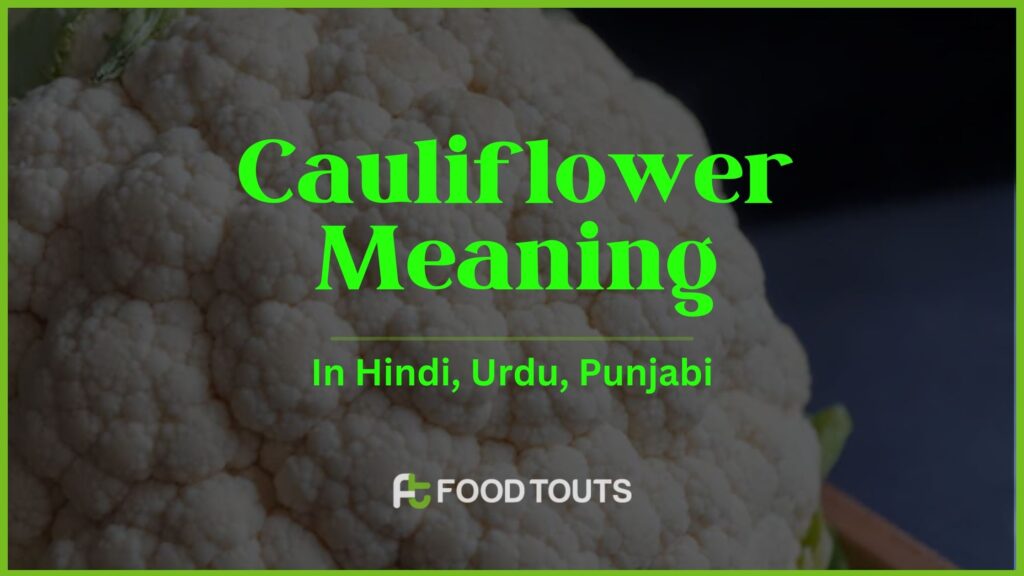Cauliflower is loved by food lovers worldwide because of its versatility and unique flavor.
Cauliflower is a popular choice for a wide range of culinary applications. It can be cooked in numerous ways, including roasting, boiling, steaming, and even mashing to create a healthier alternative to mashed potatoes. Cauliflower can also be used to make gluten-free pizza crust and rice, and even as a substitute for buffalo wings when coated in spicy sauce
What’s interesting is that it has different names in different languages. We’ll find out what “cauliflower” is called in Hindi, Urdu, Punjabi, and Persian.
1. Cauliflower Meaning in Hindi (फूल गोभी)
Cauliflower is known as “फूल गोभी” (Phool Gobhi) in Hindi . The term “Phool Gobhi” quite literally translates to “flowered cabbage,” which is a fitting description for the vegetable. In Hindi-speaking regions, Phool Gobhi is a staple in various dishes, from the iconic Aloo Gobhi (potato and cauliflower) to flavorful curries.
2. Cauliflower Meaning in Urdu (گوبهی)
In Urdu, cauliflower is referred to as “گوبهی” (Gobhi), a name that resonates with its Hindi counterpart. Urdu-speaking communities enjoy Gobhi in a multitude of dishes, including Gobhi Paratha (cauliflower-stuffed flatbread) and Gobhi Gosht (cauliflower and meat curry).
3. Cauliflower Meaning in Punjabi (ਫੁਲ ਗੋਭੀ)
Cauliflower is called “ਫੁਲ ਗੋਭੀ” (Phul Gobhi) in Punjabi, aligning closely with its names in Hindi and Urdu. Punjabi cuisine, celebrated for its rich flavors and hearty meals, features Phul Gobhi in dishes like Gobhi Matar (cauliflower and peas curry) and Gobhi Paratha.
4. Cauliflower Meaning in Persian (گل کلم)
Cauliflower is known as “گل کلم” (Gol Kalam) in Persian. The Persian name captures the essence of the vegetable’s appearance, as “Gol Kalam” translates to “cabbage flower.” In Persian cuisine, Gol Kalam is used in various dishes, including the popular Gheimeh Bademjan (eggplant and lentil stew) where it adds a delightful texture and flavor.
Exploring the names of cauliflower in different languages provides a fascinating insight into the widespread appreciation of this versatile vegetable. Whether it’s “फूल गोभी” (Phool Gobhi) in Hindi, “گوبهی” (Gobhi) in Urdu, “ਫੁਲ ਗੋਭੀ” (Phul Gobhi) in Punjabi, or “گل کلم” (Gol Kalam) in Persian, each name encapsulates the unique culinary traditions and preferences of its respective region.
Conclusion
Cauliflower, under any name, continues to be a culinary chameleon, adapting to and enhancing a wide range of cuisines. Whether you’re savoring “फूल गोभी” (Phool Gobhi) in Hindi, “گوبهی” (Gobhi) in Urdu, “ਫੁਲ ਗੋਭੀ” (Phul Gobhi) in Punjabi, or “گل کلم” (Gol Kalam) in Persian, you’re partaking in the delicious versatility that this humble vegetable brings to the world of gastronomy. Cauliflower, with its ability to transcend language and cultural barriers, unites people through its culinary prowess.

